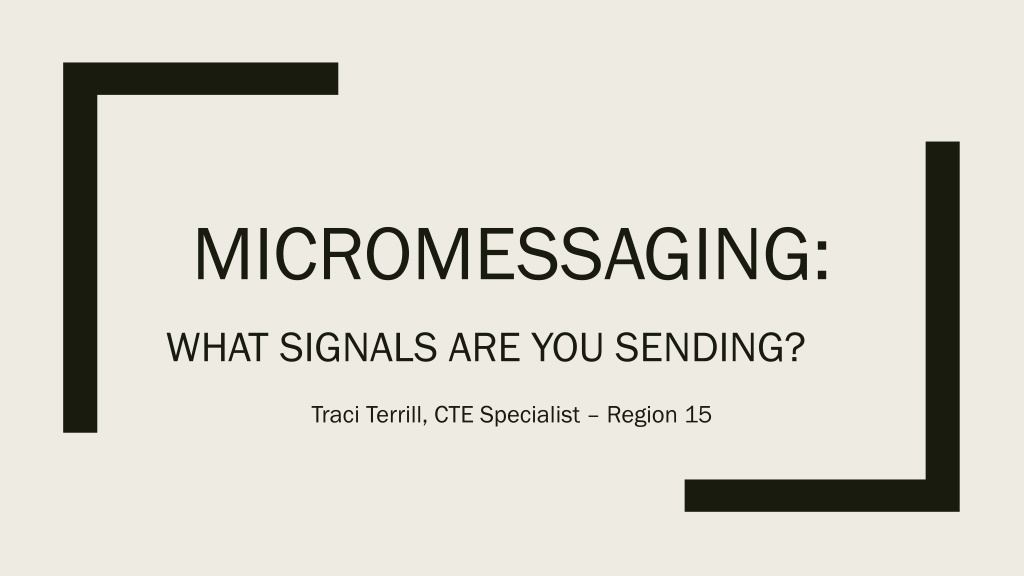Understanding Micromessaging: Hidden Impact of Subtle Behaviors
Micromessaging refers to the subtle, semi-conscious messages we send through our behaviors, both verbal and physical, that influence our interactions with others. These messages, categorized as micro-affirmations and micro-inequities, can have a significant impact on individuals. The concept delves into cultural stereotypes, implicit biases, and cues that shape how we perceive and treat others. By recognizing and addressing these micro-messages, we can work towards a more inclusive and equitable environment.
Download Presentation

Please find below an Image/Link to download the presentation.
The content on the website is provided AS IS for your information and personal use only. It may not be sold, licensed, or shared on other websites without obtaining consent from the author. Download presentation by click this link. If you encounter any issues during the download, it is possible that the publisher has removed the file from their server.
E N D
Presentation Transcript
MICROMESSAGING: WHAT SIGNALS ARE YOU SENDING? Traci Terrill, CTE Specialist Region 15
What is Micromessaging? We live and work within a diverse community. We also bring our personal experiences and cultural histories to our campus and those experiences and histories influence our everyday interactions with others. Micro-messages are small behaviors that have a big impact. Subtle, semi-conscious, universally understood messages, both verbal and physical, tell others what we really think about them. There are two kinds of micro-messages: micro-affirmations (positive messages) and micro-inequities (negative messages).
Starts with Starts with Cultural Stereotypes Behavior Framework for Cultural Change Self-efficacy Bias Accumulation of (Dis)Advantage Micromessages Point of Interruption
Cultural Stereotypes Cultural stereotypes exist about people and careers. Stereotypes are beliefs we hold within our culture that lead to assumptions about characteristics, behaviors and social norms.
Refers to the attitudes or stereotypes Refers to the attitudes or stereotypes that affect our understanding, actions, that affect our understanding, actions, and decisions in an unconscious and decisions in an unconscious manner. manner. Implicit Bias Because of stereotypes, we have implicit biases. Everyone possesses implicit biases, and these biases may not align with declared beliefs and values. Implicit biases directly affect how individuals interact with one another.
Cues Messages 1. Consistently using generic he, man, or guys to represent both men and women. 2. Rolling eyes about ideas before they may be discussed or even fully expressed. 3. Disciplining males more than females for similar behavior. 4. Phrasing teaching examples so that professionals, doctors, lawyers, scientists, are he and the weak or irrational are she . A. Females are more suited for certain roles and ill-suited for others, thus reinforcing gender stereotypes. B. Students have little of value to contribute and are not part of the educator s domain. C. Males are bad. Females can do whatever they want. D. Females are invisible and unimportant.
Cues Messages 5. Praising females more for the form and appearance of their work, and praising males more for the content of their work. 6. Giving males hints for how to solve problems for themselves, but solving females problems for them. 7. Giving females more neutral responses such as okay and Uh-huh and males more complex responses, both positive and negative. 8. Not making opportunities for females to lead class projects or activities, or more often designating them as the note- takers. E. Females are not intellectuals or capable of leadership. Females should be submissive and subservient to men. F. Females can t do it or should not appear too smart. G. Females are not as visible as the males and therefor less valuable or important in the class or course. H. Females value rest in their external attributes of appearance, not their internal attributes and academic ability.
Micromessages Micromessages are the manifestation of implicit biases. We send and receive small subtle unconscious messages when we interact with others. Not only relayed through words but also nonverbal communication.
Accumulation of Advantage or Disadvantage Positive and negative Micromessages accumulate. Each of us can identify an interaction with an educator or other significant adult in which we felt either highly valued or excluded and devalued. Although we cannot control all of the messages that students receive, we can intentionally send as many positive micro-affirmations as possible to tip the scale to an accumulated advantage.
Self Self- -efficacy is the believe one holds efficacy is the believe one holds in her or his ability to perform a in her or his ability to perform a specific task. specific task. Self-Efficacy The effect of Micromessages is high or low self-efficacy. Self-efficacy develops and changes over time, and educators can intentionally provide opportunities to bolster student self-efficacy.
Micro-Affirmations in Everyday Life What cues or micro-inequities could I relate to my experiences? What could you do or say to help students, parents, and coworkers feel: Seen Heard Valued Included Appreciated Supported
Behavior Behavior is the result of the self-efficacy. How will I increase my awareness of the influence of bias on my interactions with others?
References Adichie, C. (2009, July). Chimamanda Ngozi Adichie: The danger of a single story [Video file]. Retrieved from https://www.ted.com/talks/chimamanda_adichie_the_danger_of_a_single_story?u tm_ source=tedcomshare&utm_medium=referral&utm_campaign=tedspread Explore Nontraditional Careers. TEA/CTE Spring Meeting. National Alliance for Partnerships in Equity, Austin, Texas, April 21, 2016. [SCE Cardinals]. (2016, Feb. 16) Micromessages How Teachers Can Utilize Micromessages. [Video File]. Retrieved from https://youtu.be/bLIXJjNwsZI . [McKinsey & Company]. (2015, Sept. 15) Addressing unconscious bias. [Video File]. Retrieved from https://youtu.be/JFW2cfzevio [Soul Pancake]. (2013, Nov. 21) Kid President's 20 Things We Should Say More Often. [Video File]. Retrieved from https://youtu.be/m5yCOSHeYn4 Williams, B., PhD, & Meagan, P., PhD. (2015). Explore Nontraditional Careers. Gap, PA: National Alliance for Partnerships in Equity.

 undefined
undefined

























